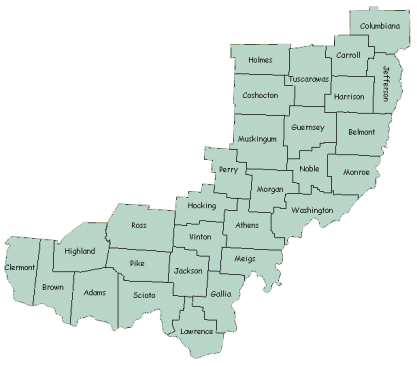
As I reflect on the problem facing the region commonly known as Appalachia, I was struck by the realization that the region is so diverse that no one solution is likely going to fit. In my ministry, I’ve served in four pastoral charges (a total of seven churches), each of which have been located in Appalachia. Further, my hometown is also in Appalachia, although it does not really fit the commonly conceived profile of the region.
Consider first New Philadelphia, which is a small city of roughly 18,000 people, located in the center of Tuscarawas County. I was born in raised here, and served my first three churches within this county. While there are parts of the county that are rural, it is far from what many would call Appalachia. New Philadelphia boasts a strong manufacturing base, a regional campus of Kent State University, and a small-town atmosphere. Add to this fact that Dover has grown right into New Philadelphia, and you have two similar towns that together have a population of about 30,000 people.
Stillwater, on the other hand, better fits the Appalachian stereotype. Located about 30 minutes south of New Philadelphia on State Route 800, this crossroads boasts a general store, a gas company (recently sold), and a dozen houses. Just off the state route is the first church I served. The people there were either retired (35%), worked in New Philadelphia/Dover (25%), and the rest farmed (25%) or were still in school (5%). The area looked to the New Philadelphia/Dover area for its continued existence.
My next two churches were in the northwest corner of Homes County. Just outside of Amish country, Lakeville was a farming community that was undergoing change. The younger families that were moving in worked in Wooster, about 20 minutes North, while many of the older families still farmed or where retired. The town’s makeup was simple: there was an elementary school, a post office, the fire department (volunteer), and the church. There was an abandoned feed mill, a closed garage/gas station, and two to three dozen houses. Just outside of town, on a Friday night, you could see dirt-track auto racing. The thing that was most striking in that area was the trailer park about two miles outside of town. When we took Thanksgiving baskets the first year, we took two to the trailer park. I have rarely ever seen so many people living in abject poverty in my life. While Lakeville fit the stereotype, the poor had been priced out of town and relegated (by their own economic means) to the trailer park.
Now I find myself in the heart of the Appalachian region, living in the midst of the stereotype. In town, there is one business, a post office, and houses. Woodsfield, the county seat, is shrinking, and we are living 45 minutes from any large population center. Thus, these people lack many of the opportunities that have existed in the communities I have lived in. Without any tangible hope, many folks down here have simply given up.
Much of what I had come to know simply as “rural ministry” has really been Appalachian ministry. There are some characteristics that have largely remained unchanged (see the post "Ten Characteristics of Appalachia", but the quality of life and the opportunities available vary widely. There is little hope that my current context will ever become as prosperous as New Philadelphia. Yet as I read many of the articles about Appalachia, Marietta, New Philadelphia, and other pockets of prosperity are lifted up as a sign of hope for the region. While I am glad that these areas are flourishing, they should not be allowed to take the eyes off of the reality that is Appalachia, the “hidden Ohio.”

No comments:
Post a Comment